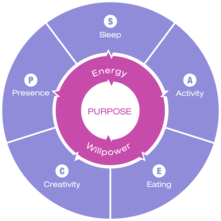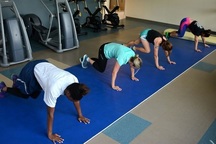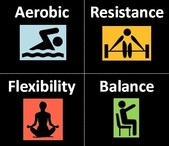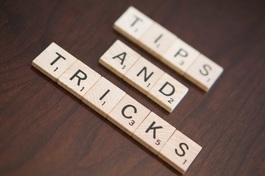|
|
|
|
|
[We] praise the strong person, the good runner, and each of the others because he naturally has a certain character and is in a certain state in relation to something good and excellent.
-Aristotle
 |
|
We're sleeping better and focused on the present, so now we continue with our work on S.P.A.C.E. (Sleep, Presence, Activity, Creativity, and Eating).
It's time to get moving.
Remember that as we move forward with each topic, we need to return our minds to our Purpose. This is our driver. Our motivation. If we want to fulfill our Purpose, we need to get enough quality sleep, be present, be active, create, and eat well. If we do these things, we will have the energy and willpower to achieve our Purpose. Or at least, head in that direction.
|
 The American College of Sports Medicine defines physical activity as "any bodily movement that is produced by the contraction of skeletal muscles and that substantially increases your energy expenditure." This broad definition includes exercise, which typically involves planned, structured, and repetitive body movement. We will take a better look at physical activity in all aspects of daily living but it may be helpful to consider activities that can be 'planned' and 'structured.'
|
|
|
 Aerobic: This type of exercise is also called 'cardio,' because it makes your lungs and heart move harder and faster. It's often divided into different levels of intensity and done for at least ten minutes at a time. Examples of high-intensity aerobic activity are jogging or running, swimming, riding a bike fast or on hills, singles tennis, etc. Moderate-intensity aerobic activity includes walking fast, water aerobics, riding a bike on level ground, doubles tennis, etc.
Resistance: This is the kind of exercise that strengthens your muscles; it involves lifting weights, working with resistance bands, doing push-ups or sit-ups, etc. Your heart and breathing rates may increase, too, but that isn't the point of resistance training.
Flexibility: These include range-of-motion activities such as neck, shoulder, upper body, chest, back, and other stretches. (Yoga is a terrific way to get more flexible.)
Balance: These exercises, which focus on the way your brain and muscles work together, include balance, agility, coordination, and gait. Yoga, qigong, and tai chi all improve these skills.
Many guidelines exist for improved health and energy. You can find and select recommendations from websites of the Centers for Disease Control and Prevention, the American College of Sports Medicine, the U.S. Surgeon General, and the American Heart Accossiation, among others.
|
|
|
 Shedding excess body fat is often best done through resistance training. It's also been shown to build muscular strength and bone density. Not into lifting heavy weights? You're in luck. Recent research finds that high-repetition, light-resistance activity (working out with dumbbells or other weight equipment, for example) also increases muscle strength and bone density.
A good way to become more physically active is with a mix of moderate-to-vigorous aerobic and resistance training, stretching, and balancing exercises. Sure, really fit people generally get most of their activity through structured exercise. But this doesn't mean that you can't get plenty of exercise in daily life. Walk your dog, bike to work, take the stairs instead of the elevator, park further away. Yard work such a mowing, raking, gardening, and shoveling is terrific; so is housework like vacuuming, ironing, or making beds.
|
Everyone's different, both in what they can and are willing to do. But as a basic principle, start with things you like, and as your physical condition improves, you just might find yourself disliking the other things less.

- Instead of exercising just one finger, let the ads play out while you get up and move your whole body. .hit the mute button and spend five minutes showing your body you care. Even a few push-ups, jumping jacks, and squats can add up fast.
- That thirty-minute phone call with a relative or close friend? If they're local, join them for a hike instead. Turn all that family reminiscing into more than just a stroll down memory lane: walk faster around the local park, or climb a hill when talk turns to juicy gossip. And if they're not local? Well, the cell phone may have turned us all into glassy-eyes zombies, but it also provides invaluable opportunities to move. Lace up your shoes and start walking while talking.
- Park from the shopping mall or grocery store so you can snag a few extra steps. How about taking the longest distance between two points once in a while?
- Shake things up at the office by scheduling your next meeting on the hoof. Take your colleagues around the corner for a brisk saunter in the fresh air. The exercise will increase blood flow, distributing more oxygen throughout the body, including your brain.
- Treat your workout the same as you'd treat an appointment with your boss or your doctor. Put it on your calendar and commit to it, no matter how much you have going on or how much you're rather stretch out on the couch for a leisurely nap. Committing to exercise can make it happen.
- Next time you meet a friend for coffee, ask for a to-go cup and get in some extra steps. Movement can actually stimulate conversation. Vitamin D from the sun, a little caffeine, and a brisk saunter around town.
- Make a micro-investment in an activity tracker and start counting your steps. There are plenty of apps for your phone, too.
- Monitoring can be motivating: "I'll hit ten thousand steps today with one more quick stroll after dinner." The benefits of increased energy, improves sleep, resilience, and stamina often show up quickly with consistent effort.
- Have a "standing" date with yourself. If you have a sedentary job with the county, set the alarm on your watch or phone to go off every hour during the day, and whenever it goes off, get up for a few minutes for a stretch or a brisk walk. It's a snooze button in reverse: a great way to reset both your body and your brain.
- Go ahead-be "that person." The one who takes the stairs instead of the elevator. Just a few steps can burn calories. Do that a few times each day and watch your stamina take flight, too.
- You don't need to get all of your exercise in at one time. Try squeezing in a few ten-minute intervals when you have time.
- Take a friendship to the next level. Become workout pals. Having a workout compadre can be motivating and keep you accountable, as well as bring a whole new dimension to your friendship.
- Next time you're walking somewhere, pick up the pace a little. Turn it into your won little Jedi mind trick: pretend you have somewhere really important to be and you're running late.
- As anyone who's taken a long flight in a cramped seat knows, holding still can be a lot more tiring than moving. The same holds true with desks and couches: after a day of zero activity, you may feel exhausted, but you can quickly turn things around with a brief burst of action.
|
|
|
|
|
|
|